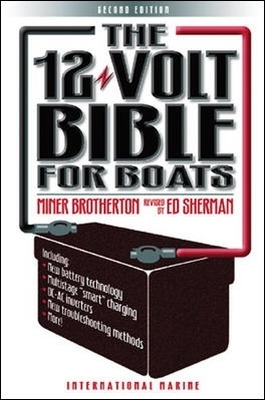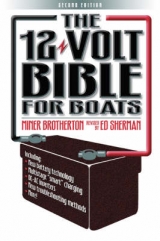
The 12-Volt Bible for Boats
McGraw Hill Higher Education (Verlag)
978-0-07-139233-4 (ISBN)
- Titel z.Zt. nicht lieferbar
- Portofrei ab CHF 40
- Auch auf Rechnung
- Artikel merken
This volume provides an introduction to the 12-volt electrical systems used on small boats to power everything from reading lights to bilge pumps. Written for boaters who are not skilled electricians, the book explains how 12-volt systems work and how to install, maintain and troubleshoot them. Since the book first came out in 1985, there have been major changes in everything from battery technology to terminal design. This revised second edition addresses major developments in several areas. The marine battery - the heart of the 12-volt system - has evolved considerably since 1985. The previous edition only covered traditional "flooded cell" batteries, which are based on liquid sulphuric acid. Flooded batteries require ventilation and maintenance, they are relatively fragile and they can release dangerous acid if damaged or overturned. The latest technology, the absorbed glass mat (AGM) battery, uses a glass filling instead of acid between the battery plates. AGM batteries are rugged, maintenance free and can be installed at any angle. (The "gel-cell" battery is based on a similar technology and offers the same benefits).
A whole new generation of devices has also developed to charge batteries: AGM and gel-cell batteries have different charging requirements, and batteries of all types perform better if charged in precise phases by modern equipment. Likewise, inverters have grown enormously in popularity since the first edition, which only treats them briefly. (Inverters take 12-volt DC power stored in the boat's battery and convert it to 120-volt AC power so that household appliances can be used Other major topics that are covered in this new edition include: new wiring conventions; the current generation of fuses, breakers and panels; modern test gear for troubleshooting; and the current generation of solar panels and wind generators.
Miner Brotherton is a longtime boater and university professor of physical sciences (retired) who excels at rendering technical boating topics in lay terms. Hometown: Bristol, Rhode Island Ed Sherman is a well-known boating writer and educator, and the author of two International Marine books: Outboard Engines (1997) and Powerboater's Guide to Electrical Systems (2000). He is the assistant director of education at the American Boat and Yacht Council (ABYC), the country's preeminent standard-making body, where he designs and teaches teacher-training programs in marine technology fields, including marine electrical systems. Prior to that, he taught marine electronics for many years at the New England Institute of Technology, in Warwick, RI, where he was chairman of the marine technology department. Hometown: Wickford, RI
AcknowledgmentsIntroduction to the Second Edition, by Ed ShermanIntroduction to the First EditionChapter 1. BASIC THEORY OF ELECTRICITY: A PrimerA Few Words of Caution The Atom and Its ElectronsThe Atom; Electrons; Molecules and Bonding; Ions and ElectronsTerms DefinedCoulomb's Law; Charge; Current; Voltage, Potential Difference, and EMF; Energy; Power; Amp-Hours; ResistanceElectricity Is Not Water, But . . . Ohm's LawIR Drops and I2R HeatChapter 2. ELECTRIC CIRCUITS: Parts of the SystemCircuit ComponentsSeries CircuitsParallel CircuitsChapter 3. THE BATTERY: Heart of the SystemPrimary and Secondary CellsPurpose and Function of the Storage BatteryWhat Happens When DischargingWhat Happens When ChargingElectrolyte and HydrometersPreventing Freezing; Using a Hydrometer; Determining Specific Gravity on Sealed BatteriesLoad Testing BatteriesStorage Battery ConstructionDifferentiating among BatteriesAnatomy of a Battery; Six-Volt Batteries; Newer Battery TypesBattery BanksSelecting a BatteryBattery Maintenance and ToolsChapter 4. THE WIRING: Electrical Veins and ArteriesProper SizeResistivity; Wire Length; ThicknessInsulationIdentification CodesTerminalsInstallationA Lesson in SolderingChapter 5. THE CONTROLS: Brains of the SystemThe Control PanelWhere to Put It?; Replacement AlternativesSwitchesMaster SwitchFusesCircuit BreakersRelaysPanel MetersChapter 6. TRANSDUCERS: Things That Do the WorkWhat Do You Need?LightsNavigation Lights; Interior Lights; Exterior LightsMotorsMotor Maintenance; Starter Motors; Refrigerator Motors; Bilge PumpsElectronicsInstallation; Power Consumption; InterferenceChapter 7. RECHARGING THE BATTERYMultiple Battery IsolatorsAlternators and GeneratorsThe RegulatorMaking Adjustments; Checking Charging Voltage; Regulator Settings; Recharge RatesAC Shore Power and Solid-State ChargersProper AC Converter/Chargers; Danger: Shock and Galvanic Corrosion; Maintaining Proper PolaritySolar CellsWind ChargersWater ChargersDC-to-AC InvertersChapter 8. TROUBLESHOOTING THE SYSTEMTroubleshooting PrinciplesTroubleshooting Instrument: The Multifunction MeterReading Ohms; Reading DC Volts; Reading AC Volts; Reading DC AmpsTroubleshooting Instrument: Test LightsA Continuity Tester; Make Your Own; Buying or Making Test LightsLocating FaultsLight Won't Work; Moisture-Related Problems; Engine Won't Start; Bilge Pump Problem; Blinking Masthead LightNoodling Out a SolutionMake a Picture; Follow a System; Tickling the Field; Simple Problems with Varying Degrees of ComplexityLeaks and Their DetectionPARTING WORD: SOME THOUGHTS ON MAINTENANCEYour Boat's Electrical ToolboxSpare Parts and JunkRESOURCESContact InformationInstallation RecordsINDEX
| Erscheint lt. Verlag | 16.12.2002 |
|---|---|
| Zusatzinfo | 30 Illustrations |
| Verlagsort | London |
| Sprache | englisch |
| Maße | 150 x 226 mm |
| Gewicht | 289 g |
| Themenwelt | Sachbuch/Ratgeber ► Sport ► Segeln / Tauchen / Wassersport |
| Technik | |
| ISBN-10 | 0-07-139233-5 / 0071392335 |
| ISBN-13 | 978-0-07-139233-4 / 9780071392334 |
| Zustand | Neuware |
| Haben Sie eine Frage zum Produkt? |
aus dem Bereich



